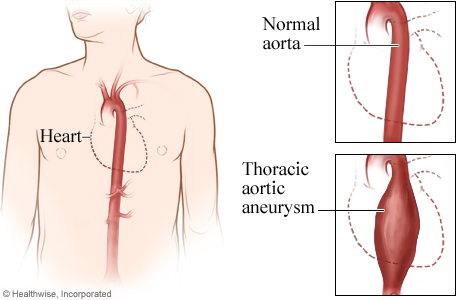Aneurysms
An aneurysm is a bulging section in the wall of a blood vessel that has become stretched out and thin. As the wall of the blood vessel bulges out, it becomes weaker and may burst or rupture, causing bleeding.
If an aneurysm in the brain bursts, it may cause a stroke. An aneurysm in a vessel that carries a lot of blood, such as the aorta, is often fatal if it bursts.
Types
Aortic aneurysm
An aortic aneurysm (say "a-OR-tik AN-yuh-rih-zum") is a bulge in part of the aorta, your main artery. If the bulge gets large enough, it can rupture. If it does, your life is in danger.
Aortic aneurysms are usually caused by hardening of the arteries (atherosclerosis). But other causes include genetic conditions, infections, and injury.
Aneurysms need to be repaired if they are large or fast-growing or if they cause symptoms. Smaller ones are usually just checked regularly to see how fast they are growing.
Thoracic aortic aneurysm

An aortic aneurysm is a stretched and bulging area in the wall of the aorta. The aorta is the large artery that carries oxygen-rich blood from the heart to the rest of the body. A thoracic aortic aneurysm happens in the section of the aorta that is in the chest.
Thoracic aortic aneurysms are also known as ascending or descending aortic aneurysms.
Brain aneurysm
A brain (cerebral) aneurysm is a bulging, weak area in the wall of an artery that supplies blood to the brain. In some cases, a brain aneurysm may cause no symptoms and go unnoticed. In other cases, the brain aneurysm ruptures. This releases blood into the skull and causes a stroke.
When a brain aneurysm ruptures, the result is called a subarachnoid hemorrhage. Depending on the severity of the hemorrhage, brain damage or death may result.
The most common location for brain aneurysms is in the network of blood vessels at the base of the brain called the circle of Willis.
Inflammatory aortic aneurysm
An aortic aneurysm is a bulging section in the wall of the aorta—the large blood vessel delivering blood from the heart to the body—that has become stretched-out and thin. Where the wall of the blood vessel bulges out, it becomes weaker and may burst or rupture, causing bleeding.
Most aortic aneurysms are caused by a combination of hardening of the arteries (atherosclerosis), genetics, and aging. But a small number are caused by inflammation. These are called inflammatory aneurysms.
An inflammatory aneurysm can cause complications, such as fever, weight loss, and symptoms of a chronic disease. A massive inflammatory response may affect body parts close to the aneurysm, including part of the small intestine, the ureter, or the veins to the kidney. Any of these structures can become obstructed by the inflammation.
Diagnosis
Angiogram
An angiogram is an X-ray test that provides pictures of the blood flow in a blood vessel. During an angiogram, a material that shows up on an X-ray (contrast material) is put into a blood vessel through a thin tube (catheter).
An angiogram may be done to look for problems such as a tear in a blood vessel that can cause blockage or bleeding, aneurysms (which are weaknesses in the blood vessel wall), and blood clots or the buildup of fatty deposits.
Sometimes a problem can be treated during angiography. For example, a catheter can be used to open a blocked blood vessel, deliver medicine to a tumor, or stop bleeding in the intestines.
Copyrighted material adapted with permission from Healthwise, Incorporated. This information does not replace the advice of a doctor.




